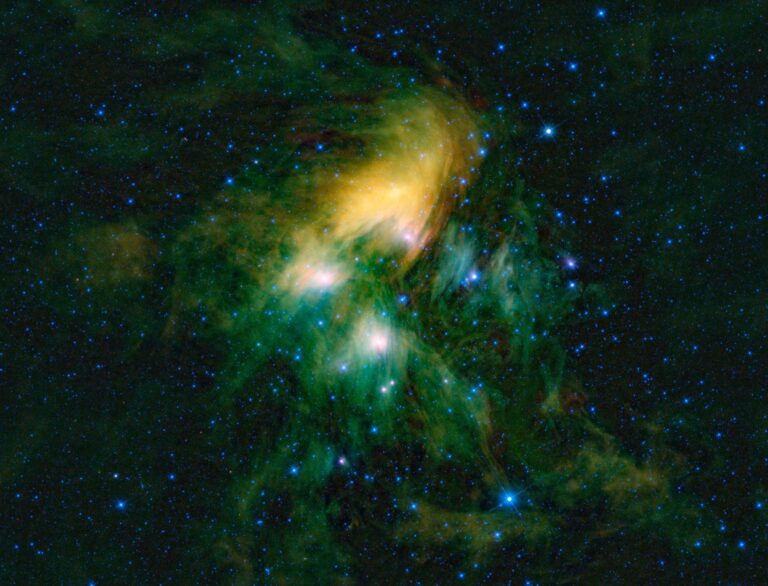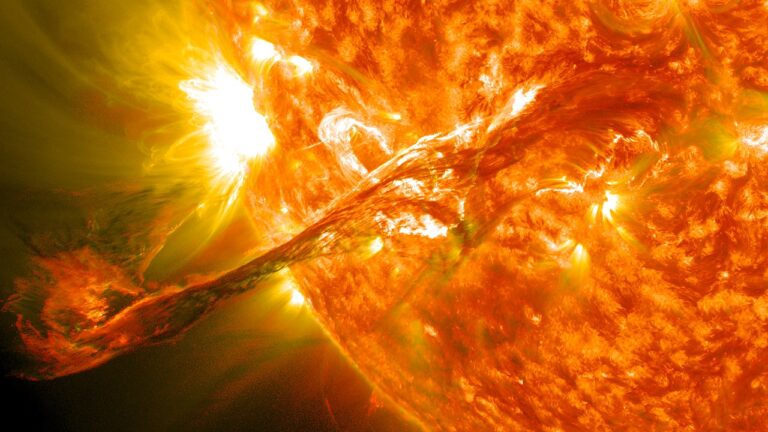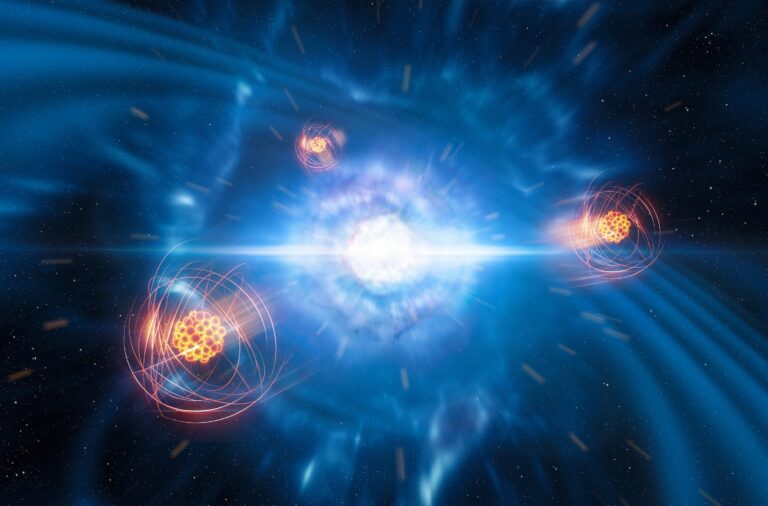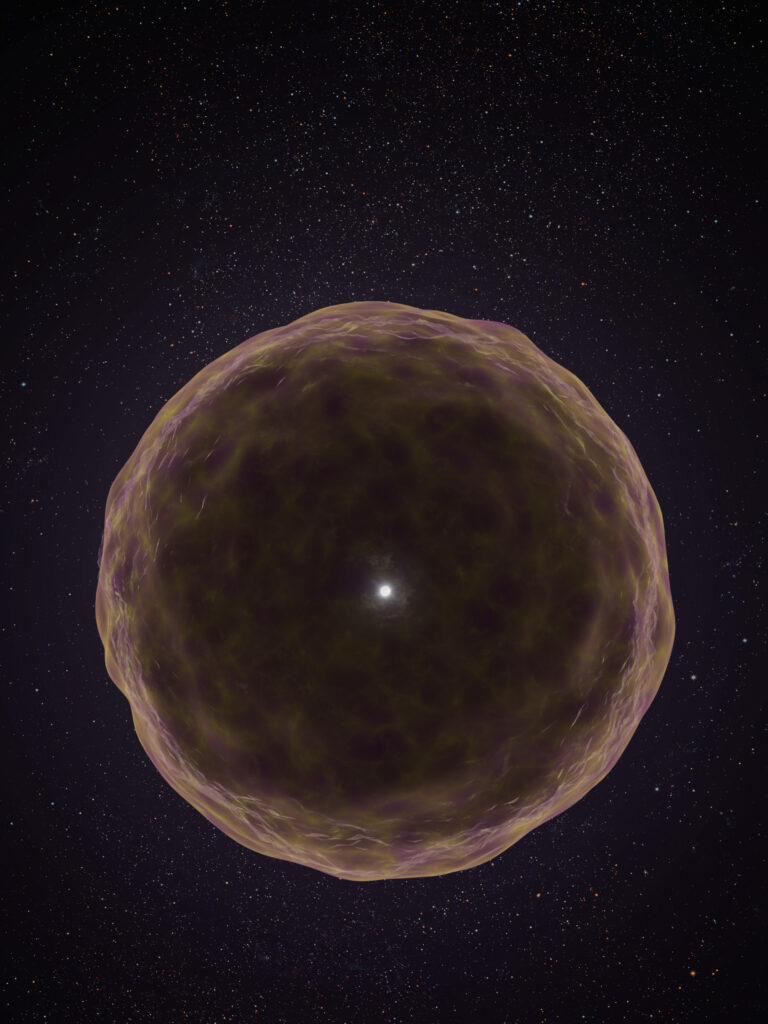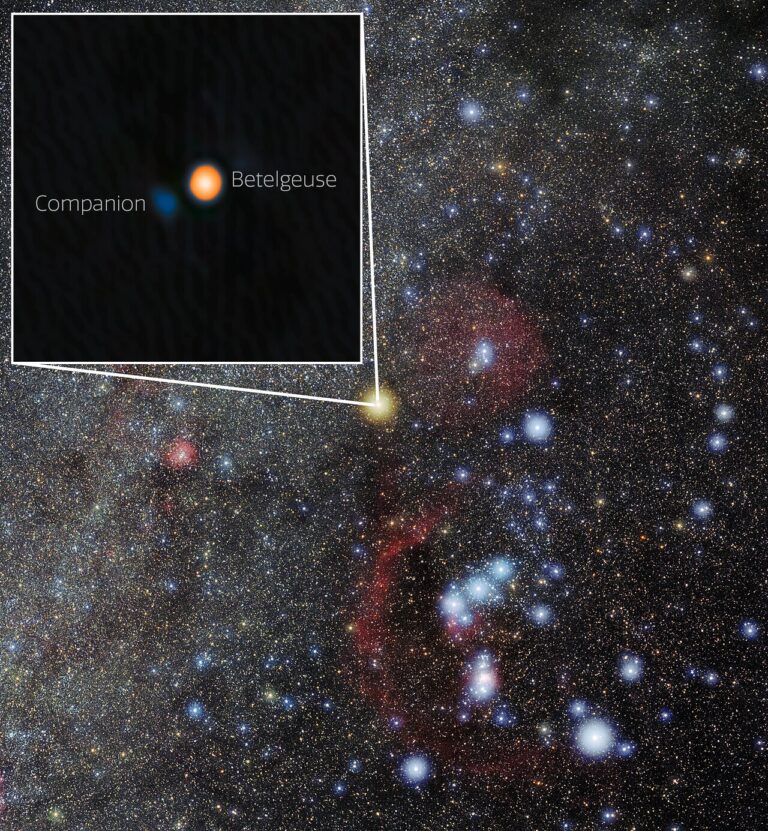
Key Takeaways:
- Supernova SN 2023zkd, located 730 million light-years from Earth, was identified as anomalous by the Light curve Anomaly Identification and Similarity Search (LAISS) AI algorithm.
- SN 2023zkd exhibited unusual pre-explosion brightening over four years and a double-peaked light curve post-explosion, deviating from typical Type IIn supernovae behavior.
- Analysis suggests SN 2023zkd resulted from a merger between a massive star and a black hole companion, evidenced by precursor emissions and the unique light curve's two peaks caused by shockwave interactions with ejected material.
- This discovery represents the strongest evidence to date for a supernova triggered by a star-black hole merger and highlights the potential of AI in identifying rare astronomical events.
Using an AI algorithm, astronomers have discovered a new type of supernova likely resulting from the merger of a dying star and its black hole companion.
In July 2023, the Zwicky Transient Facility discovered supernova SN 2023zkd, located 730 million light-years from Earth. Six months later, in January 2024, an artificial intelligence algorithm known as the Light curve Anomaly Identification and Similarity Search (LAISS) flagged the explosion as anomalous.
The discovery and subsequent analysis were conducted by a team from the Young Supernova Experiment (YSE), a collaboration led by scientists at institutions including the Center for Astrophysics | Harvard & Smithsonian (CfA) and MIT. The alert from LAISS triggered immediate and widespread follow-up observations, which proved essential for capturing the detailed data needed to unravel the supernova’s highly unusual nature. The team’s findings will be published in the upcoming issue of the Astrophysical Journal and were first made public in a preprint available at arXiv.org.
A cosmic anomaly
A star spends its life in a delicate balancing act, with the outward pressure from nuclear fusion in its core pushing against the inward crush of its gravity. As hydrogen — a star’s main fuel for fusion — runs out, it begins fusing heavier and heavier elements, until this equilibrium shatters when the chain reaches iron. Fusing iron consumes energy rather than releasing it, so the star’s engine abruptly shuts off. With nothing to halt its collapse, gravity wins. If the star is massive enough, the core implodes and the star’s outer layers rebound off the newly formed, ultra-dense object, launching a huge shockwave. This is known as a standard type II supernova.
SN 2023zkd belongs to a special subclass called type IIn. The “n” signifies that the explosion happens inside a dense cloud of gas the star previously shed. The supernova’s shockwave slamming into this material creates a complex light show. But even for this chaotic class of events, SN 2023zkd stood out as exceptionally strange.
RELATED: The different types of supernovae explained
What makes SN 2023zkd so unique? Observations revealed two behaviors that depart from a typical supernova. For one, the star wasn’t quiet before it died — it had been brightening for at least four years before its final detonation. Secondly, after the initial blast, the explosion didn’t just fade away. It dramatically re-brightened about 240 days later, creating a strange “double-peaked” light curve. Based on these eccentricities, astronomers now believe they have captured the strongest evidence to date for a massive star being detonated by its catastrophic interaction with a black hole companion.
“We think this might be part of a whole class of hidden explosions that AI will help us discover,” said V. Ashley Villar, an assistant professor of astronomy at Harvard University and a co-author on the study, in a CfA press release.
Precursor emission like no other
The first clues that SN 2023zkd was no ordinary explosion came from its behavior before the main event. Many type IIn supernovae are known to show so-called precursor emission of bright light as they shed mass. As mass is lost, it forms a cloud. As the process continues, material shed later runs into the existing cloud and causes it to shine brightly.
By analyzing archival data, astronomers uncovered a precursor phase stretching back at least four years, split into two distinct stages. The first, dubbed Precursor A, was a roughly 1,500-day stretch where the system was exceptionally bright, far more luminous than the typical outbursts of even the brightest type IIn supernova. This was followed by Precursor B, a final, nearly year-long ramp-up in brightness, a possible sign of a sudden increase in accretion of material from the star onto the black hole, putting the two on a collision course.
An explosion with two peaks
The star’s unusual pre-explosion activity was only half of the mystery. After a supernova detonates, its brightness typically climbs to a single, brilliant maximum peak before beginning a long, steady fade. This peak is the main event, far outshining any precursor emission. And SN 2023zkd followed this script at first.
But then, after several months of fading as expected, it did something strange: It re-brightened, reaching a second, nearly as brilliant peak about 240 days after the first. This double-peaked light curve is extremely rare. Detailed analysis revealed the cause: the two distinct precursor phases had created two different structures around the star. The first peak came from the supernova’s blast wave hitting a low-density cloud of gas ejected during the final ramp-up of Precursor B. The second, more sustained peak was caused by a collision with a thick, disklike cloud of material that had been shed earlier, during Precursor A. This complex structure suggested the dying star was under extreme gravitational stress from a nearby companion.
To get a clearer picture of what the environment around the star must look like, the team used sophisticated computer models to work out a configuration that could cause this unique light curve, or observed behavior of the supernova, over time. This confirmed that the two peaks were indeed caused by the supernova’s shockwave successively crashing into two separate structures that had been violently ejected before the final explosion.
The merger hypothesis
But what caused this unique set of circumstances? A single, isolated star simply couldn’t account for this behavior. The extreme brightness of the final precursor emission, the amount of gas ejected, and the strange structure all pointed to a far more violent and complex scenario. The scientific paper presenting the findings concluded that the most likely explanation was an “instability-induced merger with a black hole companion.”
Most stars are not born alone, but have at least one companion. In such binary systems, one star will end its life first; if it is massive enough, it will collapse into a black hole while its partner continues to burn. As the remaining star ages and expands, the black hole’s immense gravity can begin stripping gas from it in a process called accretion. As the black hole eats ever more of its companion, the pair spirals inward, plowing closer together.
Several years before the merger, the still-burning star ejected gas from its poles, all as the black hole continued to pull in material. The light from these ejections accounts for Precursor A. A final pre-supernova explosion caused the pair to suddenly inspiral quickly as the black hole began rapidly gobbling material, causing the brightening seen as Precursor B.
Alex Gagliano, lead author of the study and fellow at the NSF Institute for Artificial Intelligence and Fundamental Interactions, describes the moment that the team discovered Precursor B to Astronomy, saying, “We had a few ‘aha’ moments. One is when we decided to go back and ‘carefully’ look at the data.” The team reanalyzed the archival data and “surprise! —- we saw a years-long ‘ramp up’ to the explosion! This is a very clear prediction of a scenario involving a star and a black hole.”
After the ramp-up, as the pair plowed together, the star went supernova. Its shockwave slammed into the cloud created by Precursor B, then the disk from Precursor A, creating the signature double-peaked explosion.
While the merger-induced supernova is the leading theory, the team also considered an alternative scenario called tidal disruption, Gagliano says, in which the black hole tears the star apart before it can explode. In that case, the brilliant flash of light that looked like a supernova was not a traditional supernova, but, according to the press release, ”generated when the debris crashed into the gas surrounding it.” Gagliano explains, however, if this were the case, the team would expect “earlier brighter emission that we didn’t see in this event.” Regardless of how it happened, the outcome was the same: a single, more massive black hole left in the explosion’s wake.
A new window on stellar death
SN 2023zkd provides the most compelling case yet for a supernova triggered by the merger of a massive star and a black hole. It’s a cosmic event that has been theorized but never before observed.
Fittingly, a story that began with an automated algorithm points to a future where astronomy and artificial intelligence work hand in hand. As next-generation observatories like the Vera C. Rubin Observatory begin to generate an unprecedented flood of data, intelligent systems like LAISS will be indispensable. In the case of SN 2023zkd, the astronomy community “did take note of the event when it re-brightened,” Gagliano tells Astronomy. Yet, the advanced warning from the LAISS algorithm turned the team’s attention to the event long before then. “To our eyes, the supernova was not too unusual, but our algorithm was luckily able to pick up on it as something unusual.”
RELATED: Here are the first-ever images released by the Vera C. Rubin Observatory
With this discovery, astronomers now have a blueprint for an entirely new class of stellar death. SN 2023zkd will serve as a foundational event, helping scientists to identify and decode similar explosions in the future. It has opened a new window onto the complex lives of massive stars in binary systems, promising more discoveries to come.
“We’re now entering an era where we can automatically catch these rare events as they happen, not just after the fact,” Gagliano said in the press release. “That’s incredibly exciting.”

